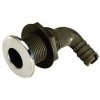- Joined
- Oct 18, 2013
- Messages
- 884
- Reaction score
- 165
- Points
- 43
- Age
- 65
- Location
- Farmingdale NJ
- Model
- Overnighter
I converted the starboard fishbox behind the helm into a recirculating livewell with a sprayer bar to fill it and aerator stone. My Grady is an ‘87 Overnighter 20. The conversion into a livewell works well but the small bottom drain designed for an icebox can’t keep up with the incoming water if it’s fully open plus it clogs with fish scales when I throw bass in. (The biggest was 43” and it was fully kicking when the boat rolled into my backyard on the trailer, yes it works that well).
Another note is that with the intake strainer open and running at speed water pushes in and overflows the drain spilling over onto the deck. It’s needs more drain capacity.
I’ve gotten a livewell drain that has a removable strainer and uses a outlet hose with an inner diameter of 1-1/2” more than twice that of the original lower drain. A hole has been drilled to mount it on the side between the box and outer hull. It was fun wire brushing the foam out to make room for the fitting and getting my big hands in through the small ports behind the box.
It’s tough to do but once done it’s done and it’ll work.
I’ve got a decision to make on where to mount the the return through hull.
It could go straight back through the transom or out the side under and a little forward of where the bulge pump exists.
I’m leaning towards going through the side as I don’t like the idea of making another hole through the wood core of the transom. The through hull requires a 2” hole.
Anyone see an issue with this location?
This is the strainer I’m installing in the box.

This is what will likely be in the hull.

Though my boat is under a carport for the winter I have only been working on it on those “Indian summer” days. Can’t get caulk to cure or me to move well when it’s freezing. :wink:
Though it’s snowing again today better weather is on the way and the bass will start moving again.
It’s time to shake winter off and be ready for the season ahead.
Mike
Another note is that with the intake strainer open and running at speed water pushes in and overflows the drain spilling over onto the deck. It’s needs more drain capacity.
I’ve gotten a livewell drain that has a removable strainer and uses a outlet hose with an inner diameter of 1-1/2” more than twice that of the original lower drain. A hole has been drilled to mount it on the side between the box and outer hull. It was fun wire brushing the foam out to make room for the fitting and getting my big hands in through the small ports behind the box.
It’s tough to do but once done it’s done and it’ll work.
I’ve got a decision to make on where to mount the the return through hull.
It could go straight back through the transom or out the side under and a little forward of where the bulge pump exists.
I’m leaning towards going through the side as I don’t like the idea of making another hole through the wood core of the transom. The through hull requires a 2” hole.
Anyone see an issue with this location?
This is the strainer I’m installing in the box.

This is what will likely be in the hull.

Though my boat is under a carport for the winter I have only been working on it on those “Indian summer” days. Can’t get caulk to cure or me to move well when it’s freezing. :wink:
Though it’s snowing again today better weather is on the way and the bass will start moving again.
It’s time to shake winter off and be ready for the season ahead.
Mike






















